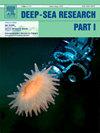Spatial variation of micrometeorite abundance in global ocean
IF 2.1
3区 地球科学
Q2 OCEANOGRAPHY
Deep-Sea Research Part I-Oceanographic Research Papers
Pub Date : 2025-05-26
DOI:10.1016/j.dsr.2025.104533
引用次数: 0
Abstract
Annually, Earth accumulates ∼40,000 tons of cosmic dust, with ∼4000–6000 tons reaching the surface as micrometeorites (MMs). This study analyzes ∼3 tons of wet sediments and ∼5000 MMs from the Central Indian Ocean Basin, using a machine learning algorithm based on terrestrial sedimentation rate (TSR) and MM abundance to identify optimal collection regions. Deep-sea sediments (TSR <0.01 cm/kyr) contain ∼50 MM/kg of dry sediments, yet remain largely unexplored. Moderately deep-sea sediments (0.01 < TSR <0.1 cm/kyr), like those in this study, average ∼15 MM/kg, while shallow-sea sediments yield far fewer. Modelling indicates that ocean regions between 45° N and 45° S latitude are ideal for MM collection. The eastern Pacific Ocean (10-40° N and 10-30° S) and the Central Indian Ocean (0-45° S) are particularly suitable. Apart from deep-sea collection, ancient rocks deposited in calm environments with low TSR (e.g. shale, claystone, mudstone, chert, and limestone) are promising for collecting fossil MMs. Overall, this research enhances micrometeorite collection strategies, enabling more accurate flux estimation and providing a foundation for researchers to effectively target specific ocean areas and ancient rock formations, thereby facilitating investigations into extraterrestrial activities and their impacts on Earth's processes.
全球海洋微陨石丰度的空间变化
地球每年积累4万吨宇宙尘埃,其中有4000 ~ 6000吨以微陨石(mm)的形式到达地球表面。本研究分析了来自中印度洋盆地的~ 3吨湿沉积物和~ 5000 MM,使用基于陆地沉积速率(TSR)和MM丰度的机器学习算法来确定最佳收集区域。深海沉积物(TSR <0.01 cm/kyr)含有约50 MM/kg的干沉积物,但大部分尚未开发。中深海沉积物(0.01 <;与本研究一样,TSR (0.1 cm/kyr)平均为~ 15 MM/kg,而浅海沉积物的产量要少得多。模拟表明,北纬45°至南纬45°之间的海洋区域是收集MM的理想区域。东太平洋(北纬10-40°和南纬10-30°)和印度洋中部(南纬0-45°)特别适合。除深海收集外,沉积在低TSR平静环境中的古岩石(如页岩、粘土岩、泥岩、燧石和石灰岩)也有可能收集化石mm。总体而言,本研究增强了微陨石收集策略,使通量估算更加精确,为研究人员有效瞄准特定海洋区域和古岩层提供了基础,从而促进了对地外活动及其对地球过程影响的研究。
本文章由计算机程序翻译,如有差异,请以英文原文为准。
求助全文
约1分钟内获得全文
求助全文
来源期刊
CiteScore
4.60
自引率
4.20%
发文量
144
审稿时长
18.3 weeks
期刊介绍:
Deep-Sea Research Part I: Oceanographic Research Papers is devoted to the publication of the results of original scientific research, including theoretical work of evident oceanographic applicability; and the solution of instrumental or methodological problems with evidence of successful use. The journal is distinguished by its interdisciplinary nature and its breadth, covering the geological, physical, chemical and biological aspects of the ocean and its boundaries with the sea floor and the atmosphere. In addition to regular "Research Papers" and "Instruments and Methods" papers, briefer communications may be published as "Notes". Supplemental matter, such as extensive data tables or graphs and multimedia content, may be published as electronic appendices.

 求助内容:
求助内容: 应助结果提醒方式:
应助结果提醒方式:


